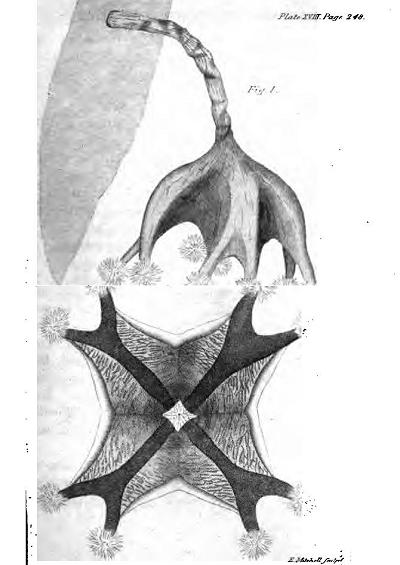STAUROMEDUSAE UK
An online guide to the Stalked jellyfish (Stauromedusae) found
around the coastal waters of the United Kingdom and Ireland.
Includes notes on their identification, and where and how to find them.
6. Lucernaria fascicularis.
Substance gelatinous; colour dark-brown, nearly opake. Tail cylindrical, flexuous, wrinkled, extensile, and somewhat narrower at the base, where it adheres to broad-leaved Fuci. Body bell-shaped, sub-quadrangular, concave within. Margin divided into four arms, which are broad at the base, divided at the top, and concave within. On the top of each of the divisions of the arms, there is a fasciculus of tentacula, upwards of a hundred in number. The mouth is placed in the centre, and consists of a loose tubular membrane, sometimes four-notched at the tip, but often, at the pleasure of the animal, expanded, circular, or striated.
Internally, the animal appears to be divided into four compartments, reaching from the centre to the margin between the arms. The divisions are formed by a thin membrane from the four corners of the mouth. On each side of these divisions, a thick corrugated band extends from the centre, almost to the border of the margin. The bands are intestines of the animal. The insides of the mouth contains numerous white filaments.
The animal contracts itself into various shapes. It moves the tentacula very quickly, especially if muddy water is poured upon it. Although I have kept it alive several days, I have never observed it in an upright position. It in general hangs downwards, as expressed in the figure, sometimes, however, it is nearly horizontal.
It is chiefly found on the leaves of Fucus digitatus, and F. esculentus, which grows in deep water. It is common in Zetland.
At first I was disposed to consider this species as the Lucernaria quadricornis of Muller, (Zool. Dan. i. tab. 39. fig. I.); but a more careful comparison of the figure and description with the Zetland specimens, has convinced me of the propriety of viewing them as distinct species. In L. quadricornis, the branches of the arms are represented as terminating in a fasciculus of about forty tentacula; whereas, in L. fascicularis, the tentacula are upwards of a hundred in number. - (Communicated 9th December 1809.)
